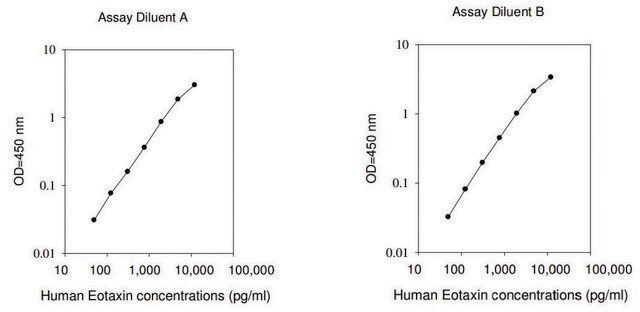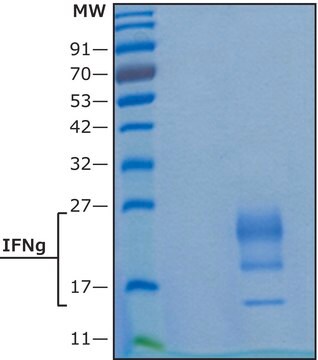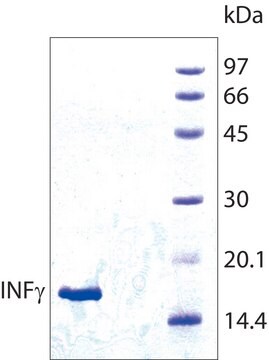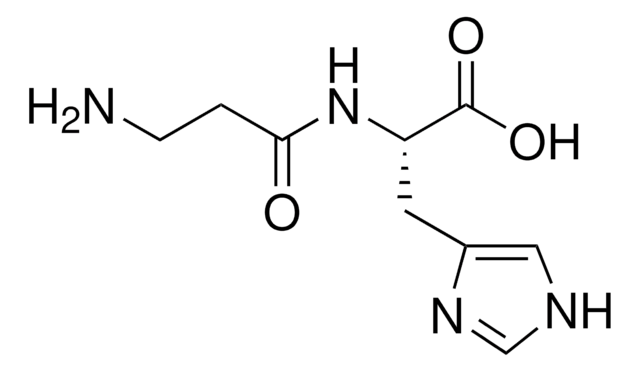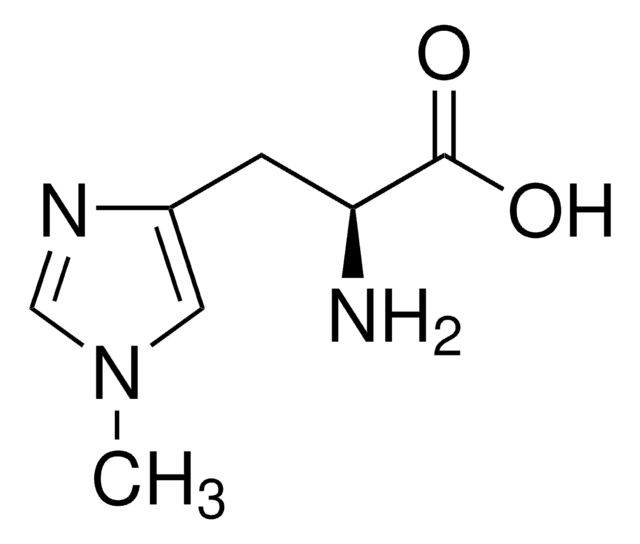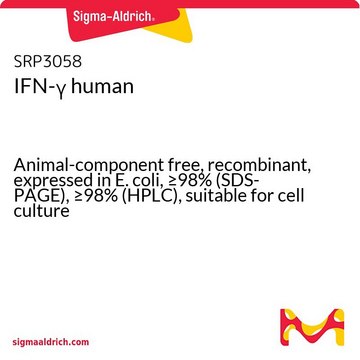Alle Fotos(1)
Wichtige Dokumente
E8399
Eotaxin-3 human
>97% (SDS-PAGE), recombinant, expressed in E. coli, lyophilized powder, suitable for cell culture
Synonym(e):
CCL26, SCYA26
Anmeldenzur Ansicht organisationsspezifischer und vertraglich vereinbarter Preise
Alle Fotos(1)
About This Item
Empfohlene Produkte
Biologische Quelle
human
Qualitätsniveau
Rekombinant
expressed in E. coli
Assay
>97% (SDS-PAGE)
Form
lyophilized powder
Wirksamkeit
0.25-1.0 mg
Mol-Gew.
~8.2 kDa
Verpackung
pkg of 25 μg
Lagerbedingungen
avoid repeated freeze/thaw cycles
Methode(n)
cell culture | mammalian: suitable
Verunreinigungen
endotoxin, tested
UniProt-Hinterlegungsnummer
Lagertemp.
−20°C
Angaben zum Gen
human ... CCL26(10344)
Allgemeine Beschreibung
Eotaxin-3, also known as CCL26 or SCYA26, is a human CC chemokine and a functional ligand for CC chemokine receptor 3. This gene is localized to human chromosome 7q11.2, which codes for a protein of 71 amino acids. It belongs to the small inducible cytokine subfamily A , which also includes eotaxin and eotaxin-2.
Biochem./physiol. Wirkung
Eotaxin-3 is a potent attractant of eosinophils, and might be responsible for the accumulation of eosinophils in atopic diseases. As it is involved in the recruitment of eosinophils in inflammatory diseases, it, along with its receptor, might have potential as therapeutic target in inflammatory disorders, such as asthma. Demethylation results in increased expression of this gene, which in turn influences allergic reactions. This gene is overexpressed in bullous pemphigoid (BP), which results in the accumulation of eosinophils in skin lesions, thus, contributing to the pathogenesis of BP. Its expression is also elevated in the active lesions of patients with ulcerative colitis (UC) and Crohn′s disease (CD). Thus, it might play a role in the pathogenesis of UC, where its major source is colonic myofibroblasts.
Eotaxin-3, also known as CCL26 or SCYA26, is a human CC chemokine and a functional ligand for CC chemokine receptor 3. Mature recombinant human eotaxin-3 has a molecular mass of approximately 8.2 kDa and demonstrates chemotactic activity for eosinophils.
Physikalische Form
Lyophilized from a 0.2 μm filtered solution in 30% acetonitrile and 0.1% trifluoroacetic acid containing 1.25 mg bovine serum albumin.
Hinweis zur Analyse
The biological activity is measured by its ability to induce chemotaxis of rat Y3 cells stably expressing hCCR3.
Signalwort
Warning
H-Sätze
Gefahreneinstufungen
Acute Tox. 4 Inhalation - Eye Irrit. 2
Lagerklassenschlüssel
11 - Combustible Solids
WGK
WGK 2
Flammpunkt (°F)
Not applicable
Flammpunkt (°C)
Not applicable
Hier finden Sie alle aktuellen Versionen:
Besitzen Sie dieses Produkt bereits?
In der Dokumentenbibliothek finden Sie die Dokumentation zu den Produkten, die Sie kürzlich erworben haben.
Eunjin Lim et al.
Journal of immunology (Baltimore, Md. : 1950), 192(1), 466-474 (2013-12-11)
DNA demethylation has been primarily studied in the context of development biology, cell fate, and cancer, with less attention on inflammation. In this article, we investigate the association between DNA methylation and production of the chemoattractant cytokine eotaxin-3 in the
M Kitaura et al.
The Journal of biological chemistry, 274(39), 27975-27980 (1999-09-17)
Previously, we mapped the novel CC chemokine myeloid progenitor inhibitory factor 2 (MPIF-2)/eotaxin-2 to chromosome 7q11.23 (Nomiyama, H., Osborne, L. R., Imai, T., Kusuda, J., Miura, R., Tsui, L.-C., and Yoshie, O. (1998) Genomics 49, 339-340). Since chemokine genes tend
C Günther et al.
Clinical and experimental immunology, 166(2), 145-153 (2011-10-12)
Eosinophils contribute to the pathogenesis of bullous pemphigoid (BP) by secretion of proinflammatory cytokines and proteases. Trafficking of eosinophils into tissue in animal models and asthma depends on interleukin-5 and a family of chemokines named eotaxins, comprising CCL11, CCL24 and
R F Guo et al.
Genomics, 58(3), 313-317 (1999-06-22)
By searching the Expressed Sequence Tag database, a full-length cDNA for a novel human CC chemokine was cloned. This cDNA encoded a 94-amino-acid protein with a putative signal peptide of 26 amino acids. The deduced mature protein had the four
A Shinkai et al.
Journal of immunology (Baltimore, Md. : 1950), 163(3), 1602-1610 (1999-07-22)
IL-4 has been shown to be involved in the accumulation of leukocytes, especially eosinophils, at sites of inflammation by acting on vascular endothelial cells. To identify novel molecules involved in the IL-4-dependent eosinophil extravasation, cDNA prepared from HUVEC stimulated with
Unser Team von Wissenschaftlern verfügt über Erfahrung in allen Forschungsbereichen einschließlich Life Science, Materialwissenschaften, chemischer Synthese, Chromatographie, Analytik und vielen mehr..
Setzen Sie sich mit dem technischen Dienst in Verbindung.